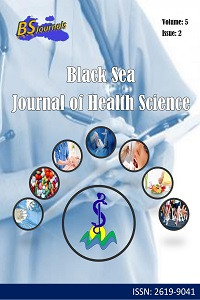Abstract
Tüm diğer canlılar gibi insanlar da yeryüzündeki fizik kanunları çerçevesinde doğar ve yaşarlar. Ancak bu durum 20 yy. ortasından itibaren değişmiş ve insanlar, uzay yolculuklarına başlayarak, bu kuralların dışında yaşamayı tecrübe etmeye başlamıştır. Uzay, düşük yerçekimi (mikrogravite) ve kozmik radyasyon gibi zorlukları olduğu gibi, uzay araçları (Uluslararası uzay istasyonu-ISS da dahil) da kısıtlı bir alana mahkum olma, izolasyon, aile ve sosyal çevreden ayrı kalma gibi güçlükleri de beraberinde getirmektedir. Tüm bu zorluklar, insan fizyolojisi ve psikolojisine de etki etmektedir. Özellikle sinirbilim alanında bu sorunları, denge (vestibuler sistem), uzay oryantasyonu, görme, propriyosepsiyon, motor kontol ve uyku konusunda görmek mümkündür. Bu problemlerin anlaşılması ve tedavisi için yerdeki kontrol merkezi ile daima iletişim kurulur. Ayrıca uzay aracı içinde bulunan tanı araçlarından da yararlanılır. Taşınabilir olması ve kullanımı kolay olduğu için en sık kullanılan yöntemlerden birisi elektroensafalogramdır (EEG). Şu ana kadar daha çok yer işgal eden ve ağır bir cihaz olan MRG (Manyetik Rezonans Görüntüleme) ve CT (Bilgisayarlı Tomografi) uzaya taşınamamış, sadece astronotların uzay uçuş öncesi ve sonrası beyin görüntüleri alınabilmiştir. Bu derleme yazısı sınırlı literatür bilgisi ışığında astronotların uzay uçuşu sırasındaki EEG değişikliklerini kısmen de olsa açıklayabilmek üzere hazırlanmıştır.
Keywords
Supporting Institution
Yok
Project Number
Yok
References
- Cebolla, A., Petieau, M., Dan, B., Balazs, L., McIntyre, J., Cheron, G. 2016. Cerebellar contribution to visuo-attentional alpha rhythm: insights from weightlessness. Sci Rep 6, 37824.
- Cheron, G., Leroy, A., De Saedeleer, C., Bengoetxea, A., Lipshits, M., Cebolla, A., Servais, L., Dan, B., Berthoz, A., McIntyre, J. 2006. Effect of gravity on human spontaneous 10-Hz electroencephalographic oscillations during the arrest reaction. Brain Res 1121,104–116.
- Clement, G., Reschke M.F. 2008. Space Neuroscience: What is it?. Neuroscience in Space. New York: Springer.
- Mathewson, K.J., Hashemi, A., Sheng, B., Sekuler, A.B., Bennett, P.J., Schmidt, L.A. 2015. Regional electroencephalogram (EEG) alpha power and asymmetry in older adults: a study of short-term test-retest reliability. Front Aging Neurosci, 7 (177), 1-10.
- Murasic, U., Meeusen, R., Pisot, R., Kavcic, V. 2014. The brain in micro- and hypergravity: The effects of changning gravity on the brain electrocortical activity. European Journal of Sport Science, 14 (8), 813-822.
- Nicogossian, A.E., Williams R.S., Huntoon, C.L., Doarn C.R., Polk, J.D., Schneider, V.S. 2016. Space Physiology and Medicine (14. Ch.Behavioral Health and Performance). New York: Springer
- Stella, A.B., Milos, A., Furlanis, G., Manganotti, P. 2021. Neurophysiological adaptations to spaceflight and simulated microgravity. Clinical Neurophysiology, 132,498-504.
- Van Ombergen, A., Demertzi, A., Tomilovskaya ,E,, Jeurissen, B., Sijbers, J., Kozlovskaya, IB., Parizel, PM., Van de Heyning, PH., Sunaert, S., Laureys, S., Wuyts, FL.2017. The effect of spaceflight and microgravity on the human brain. J Neurol., Oct;264 (Suppl 1), 18-22.
Abstract
Like all other living organisms, humans are born and live within the framework of the laws of physics on earth. However, this situation has changed since the middle of the 20th century and people have started to experience living outside these rules by starting their space travels. While space has difficulties such as low gravity (microgravity) and cosmic radiation, space vehicles (including the International Space Station-ISS) also bring difficulties such as being confined to a limited space, isolation, being separated from family and social environment. All these difficulties also affect human physiology and psychology. Especially in the field of neuroscience, it is possible to see these problems in balance (vestibular system), space orientation, vision, proprioception, motor control and sleep. The control center on the ground is always contacted to understand and treat these problems. In addition, diagnostic tools in the spacecraft are also used. Electroencephalogram (EEG) is one of the most commonly used methods because it is portable and easy to use. Until now, MRI (Magnetic Resonance Imaging) and CT (Computerized Tomography), which occupy more space and are painful devices, could not be carried into space, only brain images of astronauts before and after space flight could be taken. This review article has been prepared to explain, albeit partially, the EEG changes of astronauts during spaceflight in the light of limited literature
Keywords
Project Number
Yok
References
- Cebolla, A., Petieau, M., Dan, B., Balazs, L., McIntyre, J., Cheron, G. 2016. Cerebellar contribution to visuo-attentional alpha rhythm: insights from weightlessness. Sci Rep 6, 37824.
- Cheron, G., Leroy, A., De Saedeleer, C., Bengoetxea, A., Lipshits, M., Cebolla, A., Servais, L., Dan, B., Berthoz, A., McIntyre, J. 2006. Effect of gravity on human spontaneous 10-Hz electroencephalographic oscillations during the arrest reaction. Brain Res 1121,104–116.
- Clement, G., Reschke M.F. 2008. Space Neuroscience: What is it?. Neuroscience in Space. New York: Springer.
- Mathewson, K.J., Hashemi, A., Sheng, B., Sekuler, A.B., Bennett, P.J., Schmidt, L.A. 2015. Regional electroencephalogram (EEG) alpha power and asymmetry in older adults: a study of short-term test-retest reliability. Front Aging Neurosci, 7 (177), 1-10.
- Murasic, U., Meeusen, R., Pisot, R., Kavcic, V. 2014. The brain in micro- and hypergravity: The effects of changning gravity on the brain electrocortical activity. European Journal of Sport Science, 14 (8), 813-822.
- Nicogossian, A.E., Williams R.S., Huntoon, C.L., Doarn C.R., Polk, J.D., Schneider, V.S. 2016. Space Physiology and Medicine (14. Ch.Behavioral Health and Performance). New York: Springer
- Stella, A.B., Milos, A., Furlanis, G., Manganotti, P. 2021. Neurophysiological adaptations to spaceflight and simulated microgravity. Clinical Neurophysiology, 132,498-504.
- Van Ombergen, A., Demertzi, A., Tomilovskaya ,E,, Jeurissen, B., Sijbers, J., Kozlovskaya, IB., Parizel, PM., Van de Heyning, PH., Sunaert, S., Laureys, S., Wuyts, FL.2017. The effect of spaceflight and microgravity on the human brain. J Neurol., Oct;264 (Suppl 1), 18-22.
Details
| Primary Language | Turkish |
|---|---|
| Subjects | Health Care Administration |
| Journal Section | Review |
| Authors | |
| Project Number | Yok |
| Publication Date | May 1, 2022 |
| Submission Date | December 10, 2021 |
| Acceptance Date | December 16, 2021 |
| Published in Issue | Year 2022 Volume: 5 Issue: 2 |


